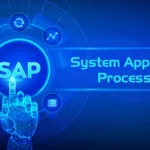A Comprehensive Guide to Implementing SAP ERP HCM in Your Organization – SAP implementation can be a compound process. It typically includes multiple phases: planning, system designing, arrangements, testing, and training. Additionally, successful implementation needs careful collaboration between IT teams, practical experts, and end-users. Moreover, the correct approach and assistance can lead the way to particular business growth and success. In A Comprehensive Guide to Implementing SAP ERP HCM in Your Organization, we will discover the main components of SAP implementation.

Accepting the critical requirement for efficient data management, business procedure automation, and perfect integration between separate teams and departments, many companies have transformed to extensive SAP systems for help. Also, we will dive into the best implementation plan. We will also discover how Bowsprit Support can help you.
What is SAP implementation?
The meaning of SAP is used for Systems, Applications, and Products. SAP implementation helps you combine SAP’s apartment of products and services into your workflows to improve your business operations. There are SAP applications and a mixture for several business functions — (CRM) customer relationship management, (SCM) supply chain management, (HCM) human capital management, and more. For example, you may gain SAP Success Factors, which is an HCM solution, to control your workforce, employee enrollment, and performance management, or SAP Ariba to make easy end-to-end obtainment procedures. SAP’s success is proof of its worldwide spread adoption. Thanks to its strong ERP solution, it is now one of the world’s biggest software companies. Now, let’s see why SAP implementation is important.
Benefits of SAP implementation
SAP implementation comes with several benefits. Here is how implementing SAP can be beneficial for your company:
- Grown operational order: Implementing SAP can smooth and computerize your organization’s procedures. For example, SAP can combine many departments, such as inventory management, finance, and sales allowing for absolute data flow and decreasing annual tasks.
- Improve decision making: SAP’s apartment of products can help the venture to combine and analyze bigger volumes of data from a variety of sources, such as sales, finance, and supply chain. Because this is real-time data, decision-making professionals can make more informed decisions. They can recognize trends and patterns in their data and maintain their strategies accordingly.
- Increased visibility and clearness: SAP helps collect data, ensuring everyone can access correct and up-to-date details. This also helps promote clearness and enhance collaboration. Real-time insights into main performance measures (KPIs) can help recognize lines and allow for timely course correction.
- Enhanced data security and governance: SAP offers data encoding and secure transmission tools, ensuring data honesty throughout its lifecycle. Moreover, SAP’s governance framework allows organizations to start and enforce data policies, entrance controls, and data quality levels.
Needs of an Effective SAP Implementation Plan
The effectuation of any SAP implementation plan depends upon meeting particular needs. We will dive into what these are, so your company can make sure of a successful implementation procedure.
- Planning and preparation – In this condition, describing a mission statement and objective is important. It builds the tone for your plan. An example mission statement could be, To execute SAP company-wide within three years with the full participation of all main collaborators. A project aim could be decreasing the list by 20%.
- Business blueprint – The blueprint document involves several sections, including organizational form, procedure flows, data models, and system combination points. the business blueprint would outline any required personalizations, like grow workflows that are not available out-of-the-box in SAP. These personalizations, along with their deliberate functionality and merging points, would be documented in the blueprint.
- Realization – The realization stage in SAP implementation is where the real system arrangements take place based on the business blueprint. It includes developing important elements, such as personalizing level SAP functionalities, making custom programs or reports, and combining external systems.
- Preparing for Implementation – In this stage, teams are required to prepare for data resetting. Also called “cutover planning,” it includes moving data from legacy systems to a SAP system, ensuring correctness and honesty. During the moving of data, check which data you want to transfer. For example, if you are performing a blanket transfer, there can be a lot of old data that may not be important.
Advantages of Implementing ERP in your organization
- Improve clearness and insights
- Increase flexibility and ease of use
- Grow productivity
- Decrease ongoing costs
- Improve customer service
- Personalize reporting
- Enhance collaborations
- Greater support.
What is HCM and its Advantages?
Human Capital Management (HCM) technology is an extensive software solution designed to help organizations manage employee data more efficiently, optimize talent lifecycles from hire to retire, and enhance employee engagement and performance over time. HCM technology allows companies to successfully manage, empower, and maximize the possibilities of their workforce. Here are the advantages of implementing HCM in your organization:
- Lower time to hire new employees
- Extended employee occupancy and higher retention rates
- Increased employee creativity and engagement across the employee lifecycle
- Mechanization and optimization of core HR functions and tasks
- Improved data authority and timeliness for greater decisions
- Increased exactness in employee performance reviews
- Collect databases for better organization and well-organized operations
Conclusion
SAP ERP HCM implementation is a complex process, but with careful planning, successful management, and a structured process, businesses can successfully cross this journey. This guide offers a complete breakdown of the SAP ERP HCM implementation phases, equipping businesses with the information they require to drive a successful SAP ERP HCM implementation plan and project. Remember, the transfer does not end with deployment. Constant support, assessment, and development are key to ensuring lasting value to your organization’s key stakeholders.
Some Frequently Asked Questions(FAQs)
Question 1 – What is an implementation in SAP HCM?
Answer – It allows all its users to automate numerous processes.
Question 2 – What does ERP stand for?
Answer – ERP stands for Enterprise Resource Planning.



